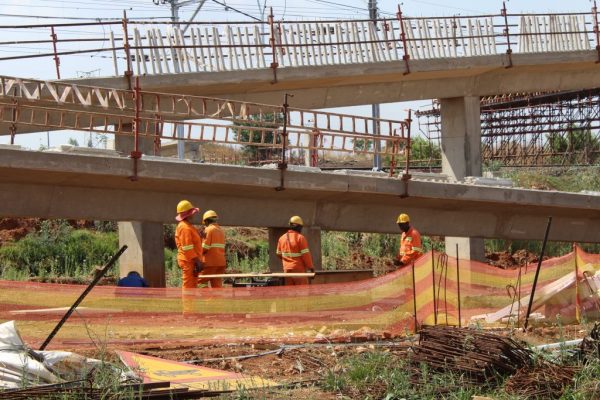Precast concrete features prominently in new JRA pedestrian bridges
Precast concrete features prominently in the design of three pedestrian bridges being built by the Johannesburg Roads Agency (JRA) in low-income communities.
These structures were designed by consulting engineer, BMK Group, which is also supervising their construction by Axton Matrix in Kaalfontein, Diepsloot and Soweto.
Both bridges in Kaalfontein and Diepsloot comprise exactly the same design. Hollow-core slabs are supported by 14 precast concrete beams, two per span and 15 m in length.
Cast-in-place methods were used to construct the four piers, two approach ramps, two abutments and sides of both bridges. This is in addition to the 150-mm-thick concrete slab on top of the hollow-core elements that reinforce the superstructure. The hollow-core slabs are first covered with polystyrene moulds with voids to reduce loading of the final concrete slab on the precast concrete beams. Services are then installed on top and covered with a steel mesh and the final concrete slab cast.
BMK Group worked with CoreCivils, a precast concrete specialist, to refine the design of the superstructures, which initially comprised a rib-and-block system. The use of hollow-core slabs provided a faster alternative of constructing the deck.
Already sized at the factory, the hollow-core slabs could be placed immediately on the precast concrete beams to complete the entire installation in a day. This also mitigated the need to coordinate delivery of construction materials in already-confined working environments.
Jaco de Bruin, MD of CoreSlab, says that hybrid-concrete construction (HCC), a combination of in-situ and precast concrete methods, has given them direct control over quality, as well as significantly fast-tracking production.
“The various elements are manufactured in a controlled setting removed from the many variables encountered on a traditional construction site and then delivered to the project to be quickly and efficiently installed,” De Bruin says.
He is also the RE for the pedestrian bridge being constructed in Soweto and for which CoreCivils manufactured and installed two precast concrete beams as part of the project.
It crosses a railway line to provide a safe and quick connection between the large communities in Chiawelo and the commercial node of Klipspruit.
This bridge is 11,6 m at its highest point and 3,1 m wide. It comprises two long approach ramps on either side with a slope of 1:12 to also cater for people who are wheelchair bound. On the Klipfontein side, the approach ramp is 55 m long and on the other side 13,1m.
The deck of the structure is supported by two 15-m-long and 1,2-m-deep reinforced concrete beams that were swiftly installed by CoreCivils’ team.
He says that the use of precast concrete beams also provided a safer means of constructing the deck as it eliminated the need to erect scaffolding close to a densely-populated area.
Notably, precast concrete has also complemented labour-based construction methods on all of these projects.
There are 19 locals working alongside Axton Matrix’s team in Soweto on this standard Expanded Public Works Programme project. Meanwhile, four black-owned small- and medium-sized enterprises have also benefitted from this build.
The in-situ works on the two projects in Kaalfontein and Diepsloot were also labour intensive. For example, about 17 locals worked alongside the main contracting team on the pedestrian bridge in Kaalfontein and an additional 20 people will be employed to work on the extended work scope, which includes the construction of about 70 m of asphalt roads and sidewalks. This is in addition to the installation of storm-water drainage, kerbing and wing walls.
De Bruin says he is proud of his team’s role in helping the JRA and its professional team deliver critical social infrastructure to poor areas.
More information from Corestruc, Tel: +27(0)87 232 2462 / www.corestruc.co.za






